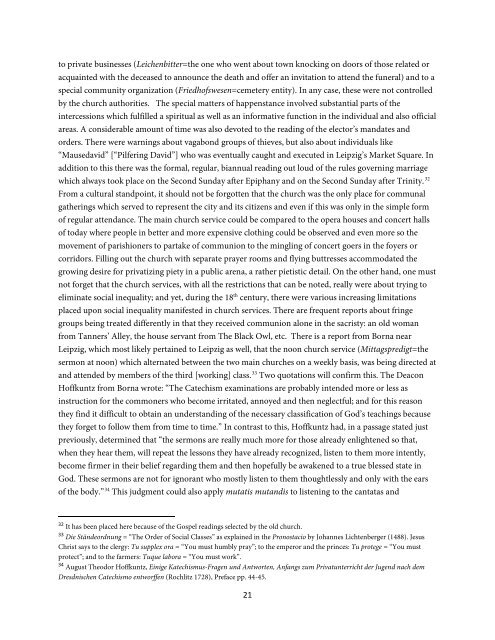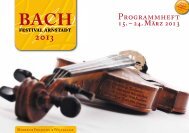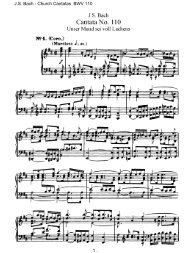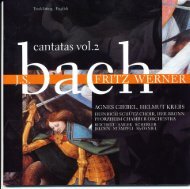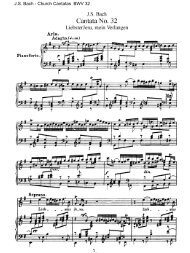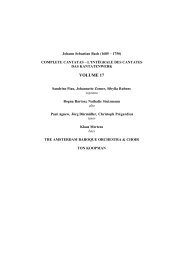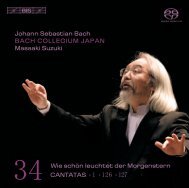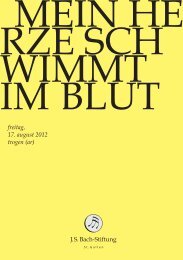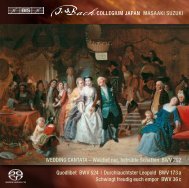Liturgy and Music in Leipzig's Main Churches - Bach Cantatas
Liturgy and Music in Leipzig's Main Churches - Bach Cantatas
Liturgy and Music in Leipzig's Main Churches - Bach Cantatas
You also want an ePaper? Increase the reach of your titles
YUMPU automatically turns print PDFs into web optimized ePapers that Google loves.
to private bus<strong>in</strong>esses (Leichenbitter=the one who went about town knock<strong>in</strong>g on doors of those related or<br />
acqua<strong>in</strong>ted with the deceased to announce the death <strong>and</strong> offer an <strong>in</strong>vitation to attend the funeral) <strong>and</strong> to a<br />
special community organization (Friedhofswesen=cemetery entity). In any case, these were not controlled<br />
by the church authorities. The special matters of happenstance <strong>in</strong>volved substantial parts of the<br />
<strong>in</strong>tercessions which fulfilled a spiritual as well as an <strong>in</strong>formative function <strong>in</strong> the <strong>in</strong>dividual <strong>and</strong> also official<br />
areas. A considerable amount of time was also devoted to the read<strong>in</strong>g of the elector’s m<strong>and</strong>ates <strong>and</strong><br />
orders. There were warn<strong>in</strong>gs about vagabond groups of thieves, but also about <strong>in</strong>dividuals like<br />
“Mausedavid” [“Pilfer<strong>in</strong>g David”] who was eventually caught <strong>and</strong> executed <strong>in</strong> Leipzig’s Market Square. In<br />
addition to this there was the formal, regular, biannual read<strong>in</strong>g out loud of the rules govern<strong>in</strong>g marriage<br />
which always took place on the Second Sunday after Epiphany <strong>and</strong> on the Second Sunday after Tr<strong>in</strong>ity. 32<br />
From a cultural st<strong>and</strong>po<strong>in</strong>t, it should not be forgotten that the church was the only place for communal<br />
gather<strong>in</strong>gs which served to represent the city <strong>and</strong> its citizens <strong>and</strong> even if this was only <strong>in</strong> the simple form<br />
of regular attendance. The ma<strong>in</strong> church service could be compared to the opera houses <strong>and</strong> concert halls<br />
of today where people <strong>in</strong> better <strong>and</strong> more expensive cloth<strong>in</strong>g could be observed <strong>and</strong> even more so the<br />
movement of parishioners to partake of communion to the m<strong>in</strong>gl<strong>in</strong>g of concert goers <strong>in</strong> the foyers or<br />
corridors. Fill<strong>in</strong>g out the church with separate prayer rooms <strong>and</strong> fly<strong>in</strong>g buttresses accommodated the<br />
grow<strong>in</strong>g desire for privatiz<strong>in</strong>g piety <strong>in</strong> a public arena, a rather pietistic detail. On the other h<strong>and</strong>, one must<br />
not forget that the church services, with all the restrictions that can be noted, really were about try<strong>in</strong>g to<br />
elim<strong>in</strong>ate social <strong>in</strong>equality; <strong>and</strong> yet, dur<strong>in</strong>g the 18 th century, there were various <strong>in</strong>creas<strong>in</strong>g limitations<br />
placed upon social <strong>in</strong>equality manifested <strong>in</strong> church services. There are frequent reports about fr<strong>in</strong>ge<br />
groups be<strong>in</strong>g treated differently <strong>in</strong> that they received communion alone <strong>in</strong> the sacristy: an old woman<br />
from Tanners’ Alley, the house servant from The Black Owl, etc. There is a report from Borna near<br />
Leipzig, which most likely perta<strong>in</strong>ed to Leipzig as well, that the noon church service (Mittagspredigt=the<br />
sermon at noon) which alternated between the two ma<strong>in</strong> churches on a weekly basis, was be<strong>in</strong>g directed at<br />
<strong>and</strong> attended by members of the third [work<strong>in</strong>g] class. 33 Two quotations will confirm this. The Deacon<br />
Hoffkuntz from Borna wrote: “The Catechism exam<strong>in</strong>ations are probably <strong>in</strong>tended more or less as<br />
<strong>in</strong>struction for the commoners who become irritated, annoyed <strong>and</strong> then neglectful; <strong>and</strong> for this reason<br />
they f<strong>in</strong>d it difficult to obta<strong>in</strong> an underst<strong>and</strong><strong>in</strong>g of the necessary classification of God’s teach<strong>in</strong>gs because<br />
they forget to follow them from time to time.” In contrast to this, Hoffkuntz had, <strong>in</strong> a passage stated just<br />
previously, determ<strong>in</strong>ed that “the sermons are really much more for those already enlightened so that,<br />
when they hear them, will repeat the lessons they have already recognized, listen to them more <strong>in</strong>tently,<br />
become firmer <strong>in</strong> their belief regard<strong>in</strong>g them <strong>and</strong> then hopefully be awakened to a true blessed state <strong>in</strong><br />
God. These sermons are not for ignorant who mostly listen to them thoughtlessly <strong>and</strong> only with the ears<br />
of the body.” 34 This judgment could also apply mutatis mut<strong>and</strong>is to listen<strong>in</strong>g to the cantatas <strong>and</strong><br />
32<br />
It has been placed here because of the Gospel read<strong>in</strong>gs selected by the old church.<br />
33<br />
Die Ständeordnung = “The Order of Social Classes” as expla<strong>in</strong>ed <strong>in</strong> the Pronostacio by Johannes Lichtenberger (1488). Jesus<br />
Christ says to the clergy: Tu supplex ora = “You must humbly pray”; to the emperor <strong>and</strong> the pr<strong>in</strong>ces: Tu protege = “You must<br />
protect”; <strong>and</strong> to the farmers: Tuque labora = “You must work”.<br />
34<br />
August Theodor Hoffkuntz, E<strong>in</strong>ige Katechismus-Fragen und Antworten, Anfangs zum Privatunterricht der Jugend nach dem<br />
Dresdnischen Catechismo entworffen (Rochlitz 1728), Preface pp. 44-45.<br />
21


